skip to main |
skip to sidebar
Ternate, Molucca Islands: Thursday, 5th February 2015
Morning: At Sea
We were not due to dock at Ternate until around noon. During Thursday morning we were passing a succession of islands to port, each of which seemed to have its own cone-shaped mountain with a much larger island, Halmahera to starboard.
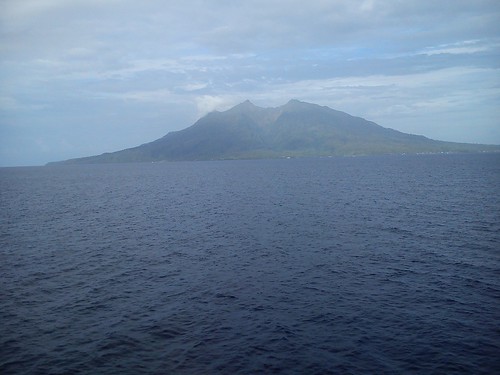 Pulau (Island) Makian viewed fron the ship.
Pulau (Island) Makian viewed fron the ship.
 Pulau Makian as shown on the ECDIS (Electronic Chart Display and Information System), in the bottom left of the screen.
Pulau Makian as shown on the ECDIS (Electronic Chart Display and Information System), in the bottom left of the screen.
At 9.30 a.m. Kathryn gave a presentation entitled ‘Indonesia’s Coastal Sultanates – links between Indonesia and Papua’. The Molucca Islands became important in the sixteenth century when explored by the European mariners, providing Europe with a source of Cloves and Nutmeg, hence the name ‘The Spice Islands’ sometimes used to refer to the Moluccas.
Crossing the Line
Then, just before 11.00 a.m., an imperious voice on the public address summoned all the passengers to the Top Deck. When we were assembled, King Neptune and his court appeared and there was pure pantomime for a while. Apparently, we were ‘Crossing the Line’ and sailing into the northern hemisphere. The Hotel Manager was in attendance and even the Captain put in an appearance. At the end of the slapstick, passengers who had not crossed the equator by ship before were invited to ‘Kiss the Fish’. Fortunately, my sea trip to the Galapagos Islands in 2006 involved 'Crossing the Line' at least twice. There's a rather breathless report on that trip here. After this forfeit had been paid, King Neptune and his entourage returned to their watery underworld.
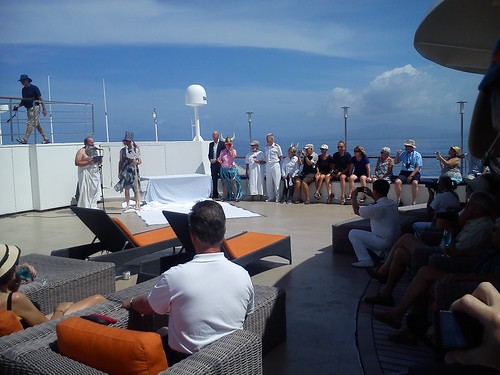 King Neptune, his 'Queen' and Courtiers.
King Neptune, his 'Queen' and Courtiers.
There's a history of this curious tradition in the Wikipedia article Line-crossing ceremony.
Ternate
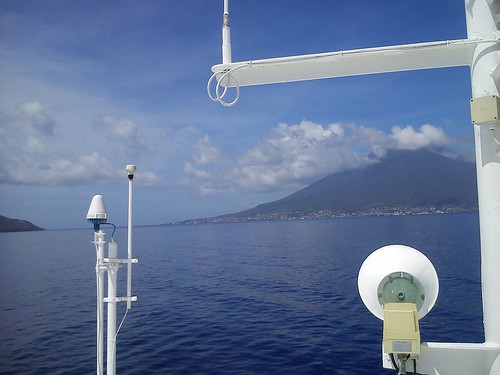 View of Ternate from the Observation Deck of 'Caledonian Sky'.
View of Ternate from the Observation Deck of 'Caledonian Sky'.
The port of Ternate was now ahead, with its own volcano, Mount Gamalama, looming over the town. The volcano is active - the eruption in 1840 destroyed most of the buildings and the most recent activity was in 2011. The population of Ternate is currently about 200,00 but I was surprised to see a number of cargo ships anchored in the approaches.
A small ‘PILOT’ launch came out to meet us and the Port Pilot clambered up the rope ladder put out by our crew. The Port Pilot, of course, assists the Captain in bringing the ship safely to the berth.
 Picking Up the Ternate Port Pilot.
Picking Up the Ternate Port Pilot.
 Approaching the jetty at Port Ternate.
Approaching the jetty at Port Ternate.
We tied-up against a jetty of reinforced concrete carried on concrete piers. I noticed that edges of the concrete dock were crumbling away. We had tied-up opposite a large terminal building with a red-painted corrugated iron roof to which the inscription ‘WELCOME TO PORT TERNATE’ had been added. The gangway had been lowered (after a little delay caused by a mooring bollard being in the way) and, once port formalities had been completed, we were invited to go ashore. Inside the terminal building, a space had been cleared with seats either side for us to watch a different ‘Welcome Dance’ by a group of young men dressed in another traditional costume.
 The 'Welcome Dance' in the terminal building.
The 'Welcome Dance' in the terminal building.
We then divided – one group of passengers drove and hiked to see what is reputed to be the ‘Oldest Clove Tree’, whilst I remained with the larger group which elected to take the ‘Ternate City Tour’. Both groups first went, by coach, to the Sultan’s Palace – a large Colonial villa built by the British.
 The Sultan's Palace in Ternate.
The Sultan's Palace in Ternate.
A traditional welcoming ceremony was held outside before we entered the Palace to shake hands with the frail-looking white-bearded present Sultan before moving through a Receiving Room with a large wooden throne beneath two parasols and an interesting Reception Room to a large, airy room where we were given sweet tea and a variety of cakes, seated on magnificent wooden furniture.
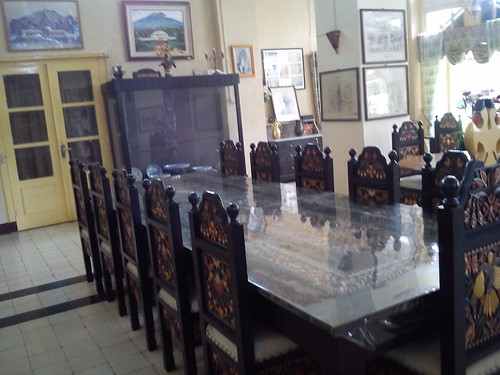 Carved, decorated furniture in the Reception Room.
Carved, decorated furniture in the Reception Room.
The faded glory of the place really appealed to me and I was quite sorry to return to the coach, pausing to look into a 2-vehicle garage holding a rather nice four-wheel carriage, complete with carriage lamps.
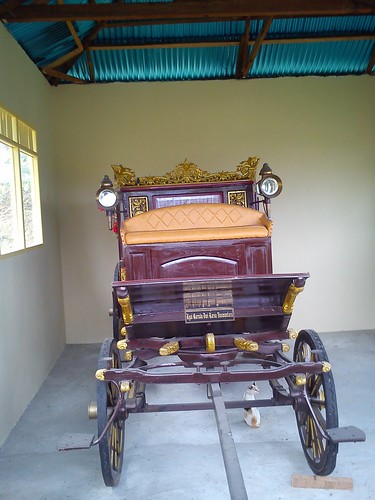
The Sultan's Carriage. When I took the picture, I didn't spot the cat.
We drove in our fleet of coaches just out of town to Batu Angus Kulaba Ternate. This is the lava field left by a previous eruption at the point where the lava entered the sea. The barren ‘moonscape’ of huge, black rocks has been rather imaginatively transformed into a memorial park. Lava has been crushed and graded to provide a series of footpaths made of small-diameter lava stone, lined both sides with edging of larger-diameter lava stone. The footpaths lead to two viewpoints overlooking the sea. A variety of trees have been planted, each set inside a white-painted rectangular frame of concrete. At a number of points around the site, the larger-diameter lava stone has been used to build a sort of hollow ‘cairn’ to serve as litter bins. I found the whole arrangement thoughtful and effective.
 One of the viewpoints in the Memorial Park.
One of the viewpoints in the Memorial Park.
Our coaches took us back towards the town, stopping near Fort Tolucco and creating a traffic jam on the narrow road. Fort Tolucco was originally built by the Portuguese but also used by other nations later. Not very much of the fort remains but it still has commanding views of the sea, the town and, inland, the threatening bulk of Mount Gamalama.
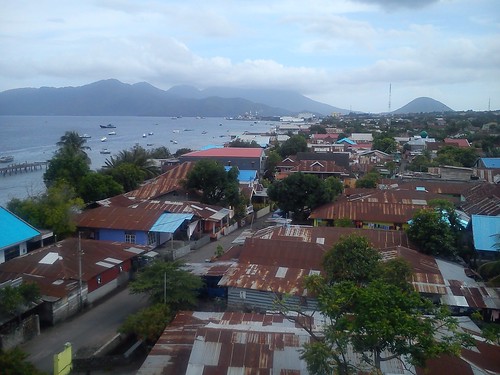 View from Fort Tolucco, showing the town and the sea.
View from Fort Tolucco, showing the town and the sea.
We made a further stop at the former home of Alfred Russel Wallace (1823 – 1913), generally acknowledged as the co-discoverer, with Charles Darwin, of the Theory of Evolution. Although Wallace became famous in his lifetime, his role has been played-down latterly and he is often depicted as a rival to Darwin. In fact, the two biologists remained friends throughout their lives and Wallace was a pall-bearer at Darwin’s funeral. The house is now a private residence but the lady occupier, who appeared to have a number of children, seemed unfazed by the invasion of a large party of foreigners.
 The bungalow-style Wallace House has broad verandahs front and rear.
The bungalow-style Wallace House has broad verandahs front and rear.
The last stop on our tour was at the market. It seemed to be in three parts: a covered market in a fairly modern building, a cramped area of a number of rows of stalls in between the market building and the road and, finally, long rows of stalls on both sides of the busy road actually in the carriageway, where the stallholders sit on the side of the stall away from the road. Shoppers, or just passers-by, are forced to walk further into the carriageway. With fairly heavy traffic in both directions whilst we were there this is, to say the least, interesting. As always, I was struck by the sheer variety of goods on offer and by the friendliness of the people, who found our presence a huge joke. After an interesting but rather hurried visit, we walked back to our waiting coaches (somehow escaping injury from the passing traffic) and were driven back to our ship after a varied and fascinating tour.
 Ternate Market.
Ternate Market.
There's an interesting article in Wikipedia called Ternate which includes a decent map which, at larger size, clarifies the bewildering array of islands.
On to Bitung
We were due to depart at 5.00 p.m. on the 154 nautical mile journey to Bitung. However, we had to await clearance from the Port Authorities who, for some reason, delayed our departure. While we waited, one of the inter-island passenger ferries (which also carry shipping containers on the foredeck) arrived and berthed next to us.
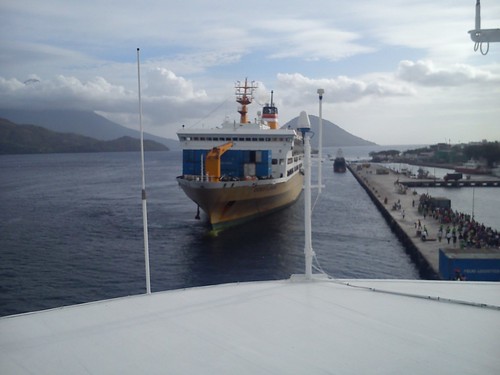 An inter-island ferry berths at Ternate as we await clearance to leave.
An inter-island ferry berths at Ternate as we await clearance to leave.
We were over two hours late leaving and, we were told later, only received clearance after Destination Asia (Noble Caledonia’s Land Agent) contacted the Mayor of Ternate who intervened with the Port Authorities. To maintain our schedule for the following day, the Captain increased our speed overnight. I’ll tell you a little about our visit to Bitung next time.
You can find all the posts on this trip here.
My pictures
Sailing to the Molucca Isles.
Ternate, Molucca Isles.
[Minor revisions, pictures and links added 27-Feb-2015]
The Boo Archipelago: Wednesday, 4th February 2015
Torobi Island Zodiac Cruise
The ship anchored off Torobi Island at around 8.30 a.m. This was an additional stop which had been inserted into the programme. Originally, we were to land on the beach but it had been decided that snorkellers would enter the water from a ‘Zodiac Platform’ and that non-snorkellers would be offered a Zodiac Nature Cruise, rather than a landing.
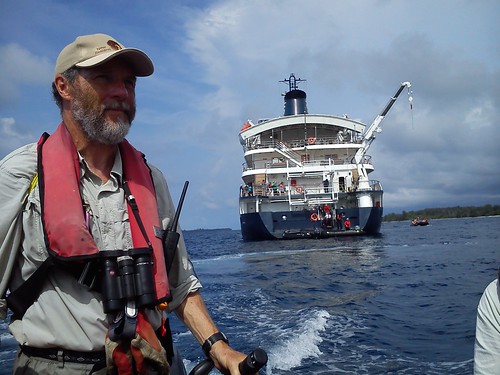 Naturalist and Zodiac Driver Simon Cook in charge of the Nature Cruise. The hydraulic crane at the stern of 'Caledonian Sky' is used to 'launch' and retrieve the Zodiacs.
Naturalist and Zodiac Driver Simon Cook in charge of the Nature Cruise. The hydraulic crane at the stern of 'Caledonian Sky' is used to 'launch' and retrieve the Zodiacs.
We made some interesting bird sightings but what particularly impressed me was the views of the wide variety of coral actually visible from the Zodiac. Firstly, the water was exceptionally clear and secondly there was not too much sea movement. The result was that, even viewing from above the surface, impressions of the magical world of the coral reef below could be obtained.
 The world beneath the surface (1).
The world beneath the surface (1).
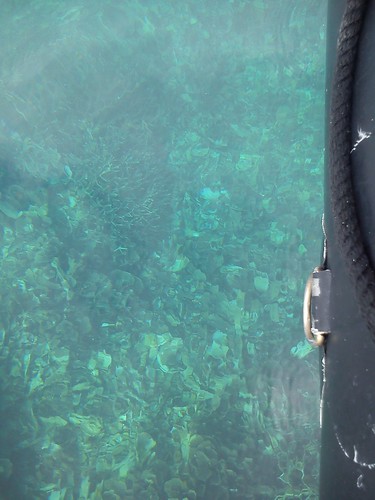
The world beneath the surface (2).
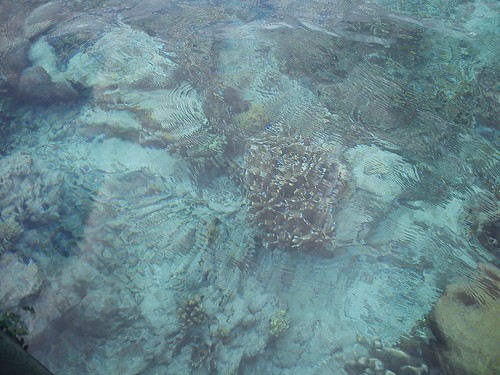 The world beneath the surface (3).
The world beneath the surface (3).
We passed one island where sea cucumbers are being grown commercially but we weren’t able to look at the ‘farm’. Apparently, sea cucumbers are regarded as a delicacy by the Japanese.
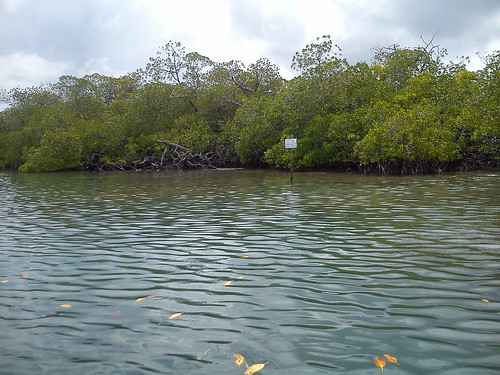 A warning sign near the sea cucumber 'farm'.
A warning sign near the sea cucumber 'farm'.
 Surrounded by islands.
Surrounded by islands.
I would have happily remained out on the Zodiac for hours but we had to return to the ship so that it could re-position to the island of Pulau Boo.
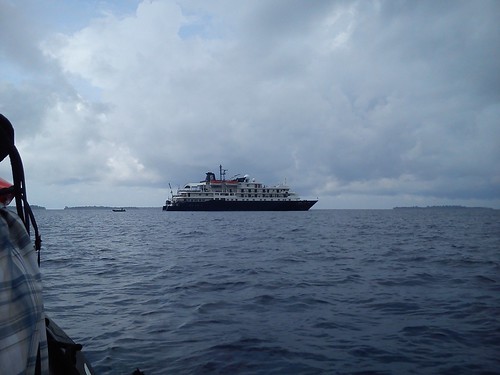 Returning to 'Caledonian Skey' for lunch. There's insufficient room in the 'cradles' at the stern to stow all the Zodiacs so a second hydraulic crane on the starboard side, just astern of the egg-shaped white 'Radome' is used to stow the other Zodiacs on the 'roof'.
Returning to 'Caledonian Skey' for lunch. There's insufficient room in the 'cradles' at the stern to stow all the Zodiacs so a second hydraulic crane on the starboard side, just astern of the egg-shaped white 'Radome' is used to stow the other Zodiacs on the 'roof'.
Whilst this was going on, the passengers took lunch on the ship, most electing for the open air ‘Lido’ restaurant on Deck 5. Unless there’s bad weather, meals could be taken ‘al fresco’ on Deck 5 or in the air conditioned comfort of the main restaurant on Deck 2, without the necessity of making a prior choice.
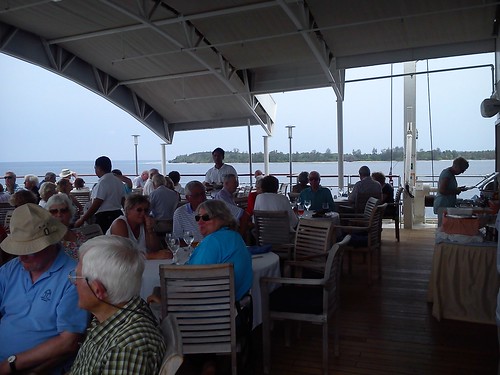 Lunch in the 'Lido' restaurant.
Lunch in the 'Lido' restaurant.
Pulau Boo Landing
Around half past two, the Zodiacs started to ferry people ashore. Separate areas were defined for the Zodiacs, snorkellers and swimmers. Pulau Boo is a small, beautiful ‘Robinson Crusoe’ island, with vegetation (mainly palms) fringed by a narrow, white beach.
 Approaching Pulau Boo in a 'Zodiac'
Approaching Pulau Boo in a 'Zodiac'
On landing, I immediately discovered that the white beach is topped with crushed coral, making footwear desirable. Whilst many of the snorkellers and swimmers were still preparing to enter the water, the sea conditions rapidly became more adverse. I was not surprised that I was making slow progress but the Expedition Team realised that more experienced snorkellers and swimmers were finding the situation uncomfortable. At first the “sphere of operations” was made more restrictive but a little later the order went out “Everybody out of the Water” so that only a small number of determined snorkellers were left in the water and a couple of Zodiacs were brought in close as safety boats.
 The beach at Pulau Boo with 'Caledonian Sky' in the background.
The beach at Pulau Boo with 'Caledonian Sky' in the background.
With swimming curtailed, I decided to walk around the island and I found a number of other passengers doing the same. The sea views were exceptional. In addition to the crushed coral, there were some fairly hefty lumps of various types of coral littered around. In general, the coral was white but I found a piece delicately lined with blue and another white inside but dark brown on the surface.
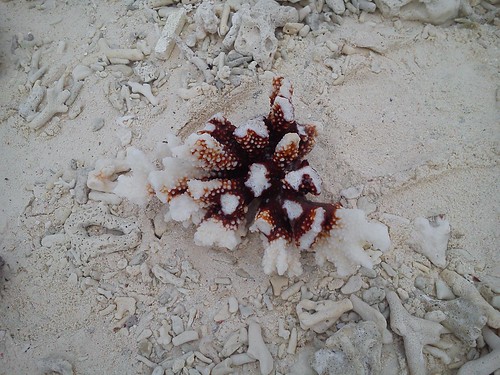 A larger piece of 'brown' coral, surrounded by coral fragments.
A larger piece of 'brown' coral, surrounded by coral fragments.
A leisurely walk took about twenty minutes for a complete circuit of the island. I made a brief foray into the palm trees. This was a complete contrast, cool with a green canopy high above. There were a number of fallen trees and large numbers of rotting coconuts lying on the ground.
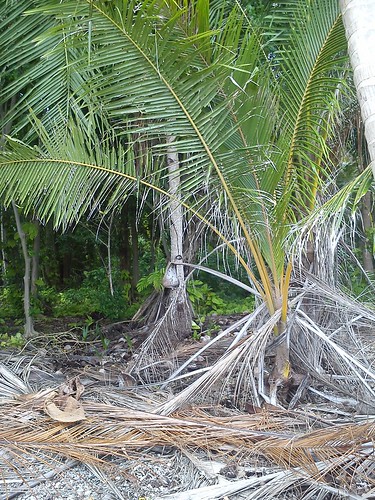
The interior of the island.
In the changed circumstances, the Expedition Team expedited our return to the ship and by about half past four, the ship was under way.
On to Ternate
Our next ‘Port of Call’, literally, was to be Ternate, in the Molucca Islands, 205 nautical miles from Pulau Boo. I’ll tell you more about our time in Ternate next time.
You can find all the posts on this trip here.
My pictures
The Boo Archipelago.
[Minor revisions, pictures and links added 24-Feb-2015 and 26-Feb-2015.]
Andamatta and Kokas: Tuesday, 3rd February 2015
On Tuesday morning, we were still travelling towards Kokas. After breakfast, I attended a lecture on the life of Captain Cook given by Danny Edmunds of the Expedition Crew.
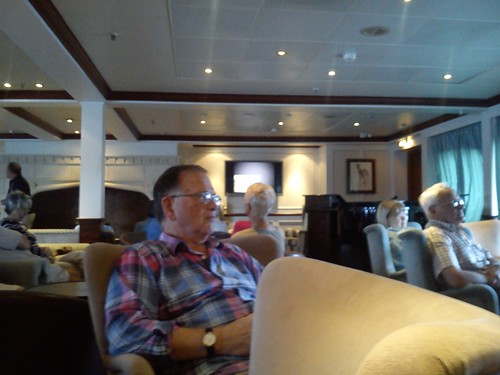 Danny (left background) delivering his talk on Captain Cook. The lounge has four screens for showing presentations, resulting in the audience looking in various directions, which I found a bit odd.
Danny (left background) delivering his talk on Captain Cook. The lounge has four screens for showing presentations, resulting in the audience looking in various directions, which I found a bit odd.
By the time Danny had completed his most interesting history, 'Caledonian Sky' had intentionally travelled beyond Kokas to moor mid-channel at Andamatta (which I think is ten nautical miles beyond Kokas).
By Zodiac to the cliff paintings of Andamatta
We set off from ‘Caledonian Sky’ in the Zodiacs but this time we were accompanied by local guides arranged by Destination Asia (the local agents used by Noble Caledonia).
 Zodiacs being made ready to take passengers to the cliff paintings (port side passengers first, then starboard side).
Zodiacs being made ready to take passengers to the cliff paintings (port side passengers first, then starboard side).
We sailed to the small island which has cliff paintings on the limestone pillar a few feet above the current water level. Known locally as ‘Tapuraran’ these pre-historic rock paintings are made using a red pigment. The primitive images appear to show scenes from the life of the people who made them. Perhaps the most haunting theme was the recurring pictures of a human hand.
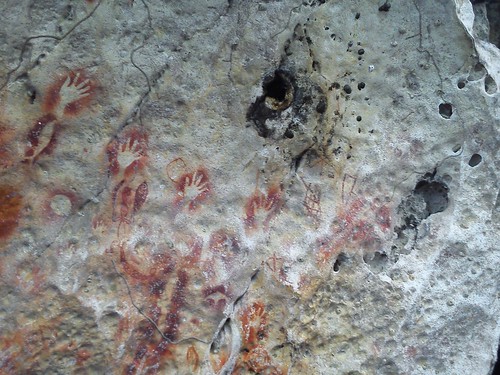 The cliff paintings of Andamatta.
The cliff paintings of Andamatta.
We returned to the ship for an early lunch starting at noon. Whilst we enjoyed another excellent meal, the ship was moved back to a position off the village of Kokas.
By Zodiac to Kokas
As we approached land in the Zodiac, we could see a neat, modern village straggling along the shore. To our left lay a modern jetty built on concrete piles but we headed to the right and landed at an older, smaller stone jetty with uneven steps leading up to road level.
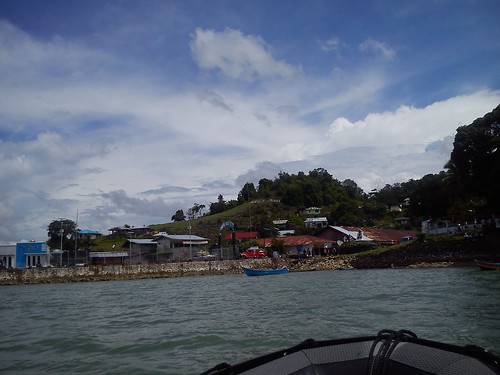 View from my Zodiac nearing the stone jetty with the road approach to the modern jetty on the left.
View from my Zodiac nearing the stone jetty with the road approach to the modern jetty on the left.
 Part of the young welcoming committee on the stone steps.
Part of the young welcoming committee on the stone steps.
Everybody was smiling as a group of local women in some sort of ‘traditional’ dress performed a Welcome Dance in the roadway. It appeared that the whole village had turned out for the event and we were soon surrounded by curious but friendly locals.
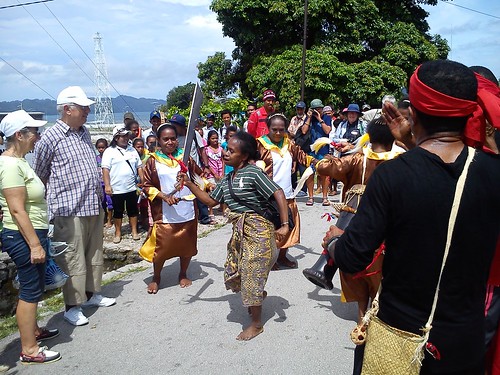 The Welcome Dance.
The Welcome Dance.
There were clearly a number of Muslims from the number of girls and women with their heads covered with colourful scarves. We were invited to walk along the shore road a short distance to a school. A temporary bamboo shelter with seats had been arranged on a grassed area outside the modern buildings where we were invited to sit. We were offered coconut milk (whole coconuts with a square section neatly ‘trepanned’ out allowing a straw to be inserted) and a variety of fresh fruits.
The performance started with a group of the youngest girl students performing an energetic Hula-Hoop dance.
 The Hula Hoop Dance.
The Hula Hoop Dance.
Then a team of women performed the dance where two parallel poles are first separated then ‘clacked’ together by two women whilst dancers try to step in between the poles without getting trapped. Two people from the ship gamely accepted the invitation to try the dance.
 The Pole Dance.
The Pole Dance.
Finally, a group of older girls in another form of ‘traditional’ dress performed a Friendship Dance. When guests were invited to join in, a number of passengers (including me) came onto the ‘floor’. Of course, they then added a couple of ‘changes’ we hadn’t seen before to confuse us but it was a jolly affair.
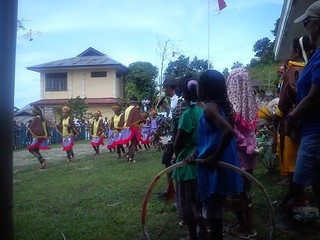
The Friendship Dance.
I’m afraid the proposed visit to the local market was scrubbed, because the market had closed (as normal) at lunchtime. But we were able to walk through the rock tunnels of the Japanese World War II bunker, rather damp and dimly illuminated by a series of pendant electric light fittings. Apparently, the bunker is only opened on special occasions so a number of the young villagers squeezed through with us.
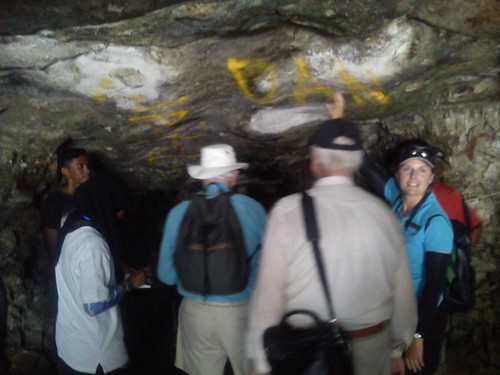 The Japanese Bunker (complete with graffiti).
The Japanese Bunker (complete with graffiti).
There was time to explore a little more of the village before returning to the stone steps and reluctantly saying farewell to the charming population before being returned to our ship by Zodiac.
 It seemed that most of the villagers had camera/phones and wanted photographs taken with their visitors.
It seemed that most of the villagers had camera/phones and wanted photographs taken with their visitors.
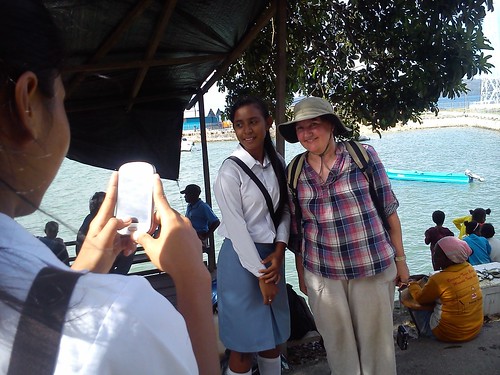 Yet more photographs!
Yet more photographs!
 Our Zodiacs returned us to the ship.
Our Zodiacs returned us to the ship.
On to the Boo Archipelago
At 4.00 p.m., the ‘Caledonian Sky’ started the journey of 201 nautical miles to the Boo Archipelago. I’ll tell you more about that area next time.
You can find all the posts on this trip here.
My pictures
Andamatta.
Kokas.
[Minor revisions, pictures and links added 24-Feb-2015.]
 Pulau (Island) Makian viewed fron the ship.
Pulau (Island) Makian viewed fron the ship.
 Pulau Makian as shown on the ECDIS (Electronic Chart Display and Information System), in the bottom left of the screen.
Pulau Makian as shown on the ECDIS (Electronic Chart Display and Information System), in the bottom left of the screen.
 King Neptune, his 'Queen' and Courtiers.
King Neptune, his 'Queen' and Courtiers.
 View of Ternate from the Observation Deck of 'Caledonian Sky'.
View of Ternate from the Observation Deck of 'Caledonian Sky'.
 Picking Up the Ternate Port Pilot.
Picking Up the Ternate Port Pilot.
 Approaching the jetty at Port Ternate.
Approaching the jetty at Port Ternate.
 The 'Welcome Dance' in the terminal building.
The 'Welcome Dance' in the terminal building.
 The Sultan's Palace in Ternate.
The Sultan's Palace in Ternate.
 Carved, decorated furniture in the Reception Room.
Carved, decorated furniture in the Reception Room.

 One of the viewpoints in the Memorial Park.
One of the viewpoints in the Memorial Park.
 View from Fort Tolucco, showing the town and the sea.
View from Fort Tolucco, showing the town and the sea.
 The bungalow-style Wallace House has broad verandahs front and rear.
The bungalow-style Wallace House has broad verandahs front and rear.
 Ternate Market.
Ternate Market.
 An inter-island ferry berths at Ternate as we await clearance to leave.
An inter-island ferry berths at Ternate as we await clearance to leave.

























